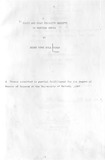| dc.contributor.author | Ogada, H T K | |
| dc.date.accessioned | 2013-05-25T10:08:55Z | |
| dc.date.available | 2013-05-25T10:08:55Z | |
| dc.date.issued | 1987 | |
| dc.identifier.citation | A thesis submitted in fulfilment for the Degree of Master of Science in the University of Nairobi. Department of Crop Science. Faculty of Agriculture. University of Nairobi. | en |
| dc.identifier.uri | http://erepository.uonbi.ac.ke:8080/xmlui/handle/123456789/25664 | |
| dc.description.abstract | This research was undertaken to contribute to the
understanding of goats and goat products markets in Western
Kenya . The survey was carried out in Kakamega district which
is one of the areas where dual purpose goats are being
bred for milk production. The objectives of the ~study were:to
identify and describe current markets for goats and goat
products, assess the possibility of grade establishment and to
examine market linkages and price changes in the marketing
system .
Both primary and secondary data were used . Primary data
were generated from livestock markets through interviews by
enumerators using structured questionnaire. Secondary data
were obtained from divisional annual reports .
Analytical techniques included,descriptive statistics,
regression and bivariate correlation analysis The survey
results showed that goat markets were unevenly distributed in
the region and was mainly influenced by volume of livestock
that can be supplied to the market from that region . It also
showed that livestock exchanges at the market favoured goats
of weights between 16-30kg .
The cold dress weight of goats were estimated at 40
percent of the live-weight. This proportion was mainly
constituted by" bone in bone out meat". The other parts were
the bowels commonly known as " matumbo" which constituted 21
percent of the animals' live weight .The price for meat and
ix
"matumbo" were controlled by the government.The price controls
were therefore only effective on up to 61 percent of the
total liveweight of goat~ .
Regression results indicated that only liveweight
attribute had significant influence on goat prices .It was
therefore desired by buyers and could be used in grading
scheme The contribution of other attributes like age and
sex had no significant influence on prices of goat~ and were
regarded as less suitable as part of any grading scheme that
can be established for goats
Weak linkages existed between markets The highest
coefficient calculated was 0.65 which was close to 0.7 which
i3 considered satisfactory(schmidt,1979).Price formation at
various market levels were also not efficient .The margins
were not indipendent from selling prices.This indicated that
traders were setting prices which deviated significantly from
perfect competitive conditions This is illustrated by
regression result betwe~n price margin and selling price .
The study recommended the establishment of pricing of
goats based on liveweight as a mens of improving price
ef,efficiency Formation of various institution like
co-operatives and other specialised agencies to perform some
market functions was suggested as part of measures designed
to improve market performance | en |
| dc.language.iso | en | en |
| dc.title | Goats and goat products markets in Western Kenya | en |
| dc.type | Thesis | en |
| local.publisher | Plant Science & Crop Protection, University of Nairobi | en |

